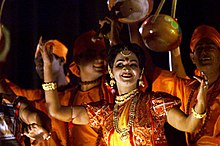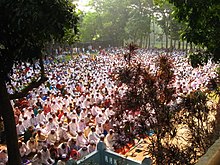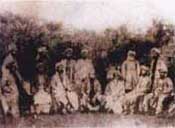Present day Bangladesh(including about two-third part of historical Bengal) has a long history in its cultures. The land, the rivers, and the lives of the Bengali people
formed a rich heritage with marked differences from neighbouring
regions. It has evolved over the centuries and encompasses the cultural
diversity of several social groups of Bangladesh. The Bengal Renaissance of the 19th and early 20th centuries, noted Bengali writers, saints, authors, scientists, researchers, thinkers, music composers, painters, and film-makers have played a significant role in the development of Bengali culture.
The Bengal Renaissance contained the seeds of a nascent political
Indian nationalism and was the precursor in many ways to modern Indian
artistic and cultural expression. The culture of Bangladesh is composite
and over the centuries has assimilated influences of Hinduism, Jainism, Buddhism, Islam, and Christianity. It is manifested in various forms, including music, dance, and drama; art and craft; folklore and folktale; languages and literature; philosophy and religion; festivals and celebrations; as well as in a distinct cuisine and culinary tradition.
Music, dance, drama, and film

The music and dance styles of Bangladesh may be divided into three categories: classical, folk, and modern. The classical style has been influenced by other prevalent classical forms of music and dances of the Indian subcontinent, and accordingly show some influenced dance forms like Bharata Nattyam and Kuchipudi.
The folk and tribal music and dance forms of Bangladesh are of
indigenous origin and rooted to the soil of Bangladesh. Several dancing
styles in vogue in the north-eastern part of the Indian subcontinent,
like monipuri and santal dances, are also practiced in
Bangladesh, but Bangladesh has developed its own distinct dancing
styles. Bangladesh has a rich tradition of folk songs, with lyrics rooted into vibrant tradition and spirituality, mysticism, and devotion.
Such folk songs also revolve round several other themes, including love
themes. Most prevalent of folk songs and music traditions include Bhatiali, Baul, Marfati, Murshidi, and Bhawaiya. Lyricists like Lalon Shah, Hason Raja, Kangal Harinath, Romesh Shill, Abbas Uddin, and many unknown anonymous lyricists have enriched the tradition of folk songs of Bangladesh. In relatively modern context, Rabindra Sangeet and Nazrul Geeti
form precious cultural heritage of Bangladesh. In recent time, western
influences have given rise to several quality rock bands, particularly
in urban centers like Dhaka. Several musical instruments, some of them
of indigenous origin, are used in Bangladesh, and major musical
instruments used are the bamboo flute (banshi), drums (dhol), a single stringed instrument named ektara, a four stringed instrument called dotara, and a pair of metal bawls used for rhythm effect called mandira, are important in the culture of Bangladesh. Currently, several musical instruments of western origin like guitars, drums, and the saxophone are also used, sometimes alongside with traditional instruments.
Festivals and celebrations
Festivals and celebrations are an integral part of the culture of Bangladesh. Prominent and widely celebrated festivals are Pohela Boishakh, Independence day, National Mourning Day, Eid ul-Fitr, Eid ul-Azha, Moharram, Durga puja, and Language Movement Day.
Eid ul-Fitr
As the most important religious festival for the majority of Muslims, the celebration of Eid ul-Fitr
has become a part of the culture of Bangladesh. The government of
Bangladesh declares the holiday for three days on Eid-ul Fitr. All
outgoing public transport from the major cities have become highly
crowded and in many cases the fares tend to rise in spite of government
restrictions.

On Eid day, the Eid prayer are held all over the country, in open areas like fields or inside mosques.[1] After the Eid prayers, people return home, visit each other's home and eat sweet dishes called shirni.
Throughout the day gentlemen embrace each other. It is also customary
for junior members of the society to touch the feet of the seniors, and
seniors returning blessings (sometimes with a small sum of money as a
gift). In the rural areas, the Eid festival is observed with great
fanfare. In some areas Eid fares are arranged. Different types of games
including boat racing, kabaddi, and other traditional Bangladeshi games, as well as modern games like cricket and football
are played on this occasion. In urban areas, people play music, visit
each other's houses and eat special food. Watching movies and television
programs has also become an integral part of the Eid celebration in
urban areas. All local TV channels air special program for several days for this occasion.
Eid ul-Adha
Main article: Eid ul-Adha
The most important religion festival. The celebration of Eid ul-Adha is similar to Eid ul-Fitr in many ways. The only big difference is the Qurbani or sacrifice of domestic animals on Eid ul-Adha. Numerous temporary marketplaces of different sizes called haat operate in the big cities for sale of Qurbani animals (usually cows and goats).
In the morning on the Eid day, immediately after the prayer, affluent
people slaughter their animal of choice. Less affluent people also take
part in the festivity by visiting houses of the affluent who are taking
part in qurbani. After the qurbani, a large portion of the meat is given
to the poor people. Although the religious doctrine allows the
sacrifice anytime over a period of three days starting from the Eid day,
most people prefer to perform the ritual on the first day of Eid.
However, the public holiday spans over three to four days. Many people
from the big cities go to their ancestral houses and homes in the
villages to share the joy of the festival with friends and relatives.
Pohela Boishakh

Pôhela Boishakh is the first day of the Bengali calendar.
It is usually celebrated on the 14th of April. Pohela Boishakh marks
the start day of the crop season. Usually on Pôhela Boishakh, the home
is thoroughly scrubbed and cleaned; people bathe early in the morning
and dress in fine clothes. They spend much of the day visiting
relatives, friends, and neighbours and going to the fair. Fairs are
arranged in many parts of the country where various agricultural
products, traditional handicrafts, toys, cosmetics, as well as various kinds of food and sweets are sold. The fairs also provide entertainment, with singers, dancers and traditional plays and songs. Horse races, bull races, bullfights, cockfights, flying pigeons, and boat racing
were once popular. All gatherings and fairs consist a wide spread of
Bengali food and sweets. The most colourful New Year's Day festival
takes place in Dhaka. Large numbers of people gather early in the morning under the banyan tree at Ramna Park where Chhayanat artists open the day with Rabindranath Tagore's famous song, Esho, he Boishakh, Esho esho (Come, year, come, come). A similar ceremony welcoming the new year is also held at the Institute of Fine Arts (Dhaka) and University of Dhaka.
Students and teachers of the institute take out a colourful procession
and parade to round the campus. Social and cultural organisations
celebrate the day with cultural programmes. Newspapers bring out special
supplements. There are also special programmes on radio and television.
Prior to this day, special discounts on clothes, furniture, electronics
and various deals and shopping discounts are available. Special line of
sarees, usually cotton,
white sarees with red print and embroidery is sold before this day as
everyone dresses up for this day. Jasmine flowers are also a huge sale
for this event which adorns the women's hair.
Background
In 1952, the emerging middle classes of East Bengal underwent an
uprising known later as the Bangla Language Movement. Bangladeshis (then
East Pakistanis) were initially agitated by a decision by the Central
Pakistan Government to establish Urdu, a minority language spoken only
by the supposed elite class of West Pakistan, as the sole national
language for all of Pakistan. The situation was worsened by an open
declaration that "Urdu and only Urdu will be the national language of
Pakistan" by the governor, Khawaja Nazimuddin. Protest
Police declared Section 144 which banned any sort of meeting. Defying
this, the students of University of Dhaka and Dhaka Medical College and
other political activists started a procession on February 21, 1952.
Near the current Dhaka Medical College Hospital, police fired on the
protesters and numerous people, including Abdus Salam, Rafiq Uddin
Ahmed, Sofiur Rahman, Abul Barkat and Abdul Jabbar, died.
The movement spread to the whole of East Pakistan and the whole
province came to a standstill. Afterwards, the Government of Pakistan
relented and gave Bengali equal status as a national language. Effects
This movement is thought to have sown the seeds for the independence
movement which resulted in the liberation of Bangladesh in 1971.
Commemoration
To commemorate this movement, Shaheed Minar (শহীদ মিনার), a solemn
and symbolic sculpture, was erected in the place of the massacre. The
day is revered in Bangladesh and, to a somewhat lesser extent, in West
Bengal as the Martyrs' Day.
This day is the public holiday in Bangladesh.
UNESCO decided to observe 21 February as International Mother
Language Day. The UNESCO General Conference took a decision to that took
effect on 17 November 1999 when it unanimously adopted a draft
resolution submitted by Bangladesh and co-sponsored and supported by 28
other countries. In Assam and North-east India
In Silchar, India, eleven people were killed by police firing on 19
May 1961 when protesting legislation that mandated the use of the
Assamese language.[1] Bengalis in Assam and north-east India observe 19
May as Language Movement Day to remember the 11 Bengalis who were killed
on the day by police fire in Silchar Railway Station. [2]
Weddings
Bengali marriage

A traditional wedding is arranged by Ghotoks
(matchmakers), who are typically friends or relatives of the couple.
The matchmakers facilitate the introduction, and also help agree the
amount of any settlement. Bengali weddings are traditionally in five
parts: first it is the bride and groom's Mehendi Shondha, the bride's Gaye Holud, the groom's Gaye Holud, the Beeya, and the Bou Bhaat.
These often take place on separate days. The first event in a wedding
is an informal one: the groom presents the bride with a ring marking the
"engagement" which is gaining popularity. For the mehendi shondha the bride's side apply henna to each other as well as the bride for the bride's Gaye Holud, the groom's family – except the groom himself – go in procession to the bride's home. Bride's friends and family apply turmeric paste to her body as a part of Gaye Hoof bride, and they are traditionally all in matching clothes, mostly orange in colour. The bride is seated on a dais, and the henna is used to decorate the bride's hands and feet with elaborate abstract designs. The sweets are then fed to the bride by all involved, piece by piece. The actual wedding ceremony
"Biye" follows the Gaye Holud ceremonies. The wedding ceremony is
arranged by the bride's family. On the day, the younger members of the
bride's family barricade the entrance to the venue, and demand a sort of
admission charge from the groom in return for allowing him to enter.
The bride and groom are seated separately, and a Kazi (authorized person by the govt. to perform the wedding), accompanied by the parents and a Wakil
(witness) from each side formally asks the bride for her consent to the
union, and then the groom for his. The bride's side of the family tries
to play some kind of practical joke on the groom such as stealing the
groom's shoe. The reception, also known as Bou-Bhaat (reception), is a party
given by the groom's family in return for the wedding party. It is
typically a much more relaxed affair, with only the second-best wedding
outfit being worn.

Architecture and heritage
Bangladesh has appealing architecture from historic treasures to contemporary landmarks.



Sports
Main article: Sport in Bangladesh

Cricket is the most popular sport in Bangladesh, followed by football. Kabaddi
is the national sport in Bangladesh. Cricket is a game which has a
massive and passionate following in Bangladesh. Bangladesh has joined
the elite group of countries eligible to play Test Cricket since 2000. The Bangladesh national cricket team goes by the nickname of the Tigers – after the Royal Bengal Tiger.
The people of Bangladesh enjoy watching live sports. Whenever there is a
cricket or football match between popular local teams or international
teams in any local stadium significant number of spectators gather to
watch the match live. The people also celebrate major victories of the
national teams with great enthusiasm for the live game. Victory
processions are the most common element in such celebrations. A former
prime minister even made an appearance after an International one day cricket match in which Bangladesh beat Australia, she came to congratulate the victory. Also in late 2006 and 2007, football legend Zinedine Zidane paid a visit to local teams and various events thanks to the invite of Nobel Peace Prize winner Dr. Muhammad Yunus.
Religion
Bangladesh is ethnically homogeneous, with Bengalis comprising 98% of
the population. The majority of Bangladeshis (about 90%) are Muslim, and a small number of Hindus, Christians and Buddhists
are also living in the country. But due to immense cultural diversity,
multiple dialects, hybridization of social traits and norms as well as
cultural upbringing, Bangladeshis cannot be stereotyped
very easily, except for the only fact that they are very resilient in
nature. People of different religions perform their religious rituals
with festivity in Bangladesh. The Government has declared National
Holidays on all important religious festivals of the four major
religions. Durga Puja, Christmas, and Buddha Purnima are celebrated with enthusiasm in Bangladesh. All of these form an integral part of the cultural heritage of Bangladesh.
Bangladesh is a land of festivity. Muslims celebrate Eid-ul-Fitr,
Eid-ul-Azha, Eid-e-Miladunnabi, Muharram etc. Hindus observe Durga Puja,
Kali Puja, and Sarashwati Puja among others. Buddha Purnima is the
biggest festival for Bengali Buddhists, and Borodin (Christmas) is
celebrated by the Christians. People from several tribal communities
also have their respective festival as well.
Apart from these religious and tribal celebrations we also have
several secular festivals. Pohela Boishakh (Bangali New Year) is the
biggest among all the festivals in Bangladesh. We also observe 21
February as Shahid Dibash (as observed worldwide as International Mother
Language Day), 26 March as Independence Day, and 16 December as Victory
Day.
Lifestyle
Cuisine

Bangladesh is famous for its distinctive culinary tradition, delicious food, snacks, and savories. Boiled rice constitutes the staple food, and is served with a variety of vegetables, fried as well with curry, thick lentil soups, fish and meat preparations of mutton, beef, and chicken, and very rarely pork only by certain small groups. Sweetmeats of Bangladesh are mostly milk based, and consist of several delights including roshgulla, sandesh, rasamalai, gulap jamun, kalo jamun, and chom-chom. Several other sweet preparations are also available. Bengali cuisine is rich and varied with the use of many specialized spices and flavours. Fish is the dominant source of protein, cultivated in ponds and fished with nets in the fresh-water rivers of the Ganges delta. More than 40 types of mostly freshwater fish are common, including carp, varieties like rui (rohu), katla, magur (catfish), chingŗi (prawn or shrimp), as well as shuţki (dried sea fish) are popular. Salt water fish (not sea fish though) and Ilish (hilsa ilisha) are very popular among Bengalis, can be called an icon of Bengali cuisine.
Serving dishes with beef is not a rare occurrence in Bangladesh. Beef curry is very common and an essential part of Bengal cuisine.
Dress

Portion of a sari woven at Sonargaon, Bangladesh.
Bangladeshi people have unique dress preferences. Bangladeshi men sometimes wear kurta or fatua on religious and cultural occasions. Bangladeshi men wear lungi as casual wear (in rural areas) and shirt-pant
or suits on formal occasions. The lungi is not considered proper to be
worn outside the house except by the farmers and the low-income
families. Shalwar Kameez and Sharee
are the main dresses of Bangladeshi women. The women also have a
different preference to which types of Shalwar Kameez and Sharee they
would like to wear. Whether it may be silk sharees, georgette sharees,
or designer sharees, each particular fabric contributes to representing
the culture overall. Weaving the fabric for these dresses is a traditional art in Bangladesh.










